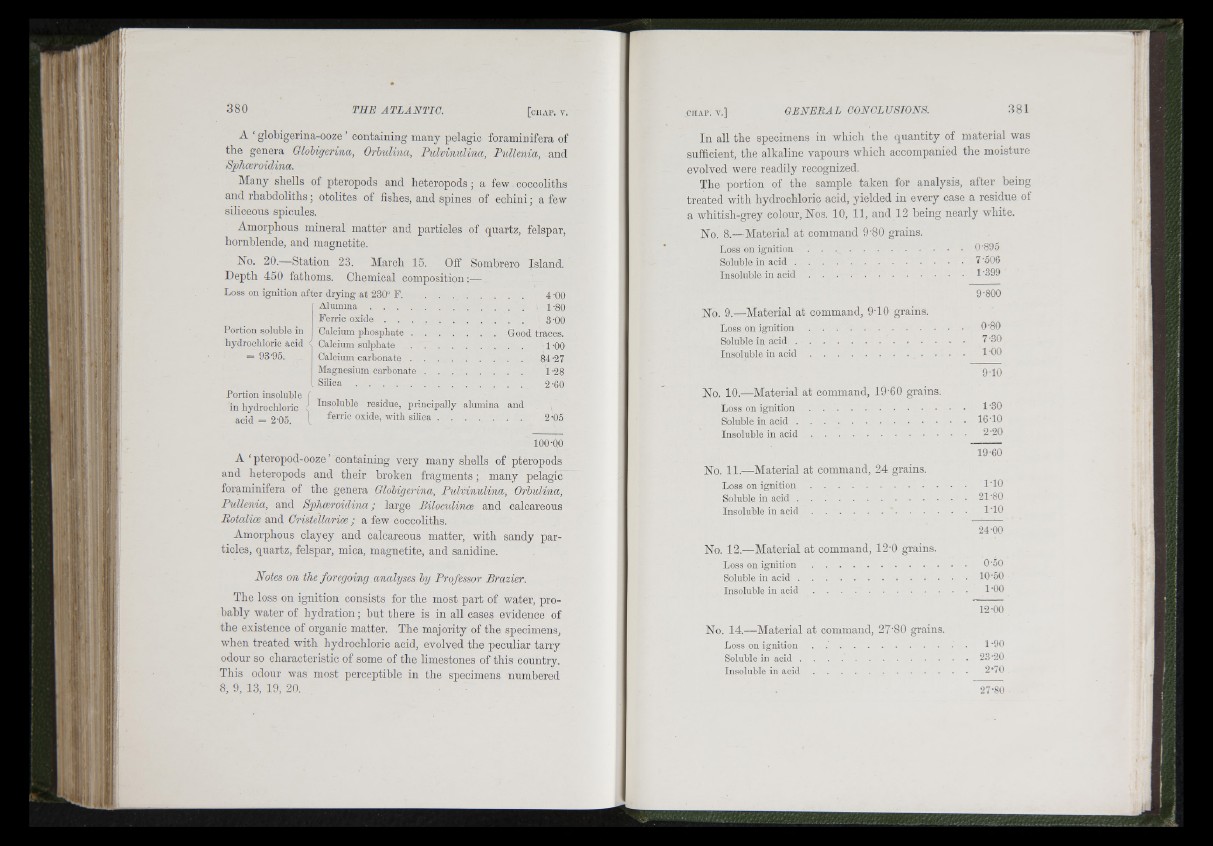
'■Tîîl :
f 1(1 "
I '
A ‘ giobigerina-ooze ’ containing many pelagic foraminifera of
the genera Glohigerina, Orbulina, Pulvinulina, Pullenia, and
Splioeroidina.
Many shells of pteropods and heteropods ; a few coccoliths
and rhabdoliths ; otolites of fishes, and spines of echini ; a few
siliceous spicules.
Amorphous mineral matter and particles of quartz, felspar,
hornblende, and magnetite.
No. 20.—Station 23. March 15. Off Sombrero Island,
Depth 450 fathoms. Chemical composition :—
Loss on ignition cafter drying a t 230“ F .................................................... 4 -QO
A l u m i n a ................................................................. L80
Ferric o x i d e ........................................................... 3-00
Calcium p h o sp h fite ........................................ Good traces.
Calcium s u l p h a t e ............................................... LOO
Calcium c a r b o n a t e .......................................................84 '27
Magnesium c a r b o n a te ......................................... 1 -28
S i l i c a ...................................................................... 2-60
Portion soluble in
hydrochloric acid
= 93-95.
Portion insoluble
in hydrochloric
acid = 2-05.
, Insoluble residue, principally alumina and
1 ferric oxide, with s i l i c a ................................... 2-05
100-00
A ‘ pteropod-ooze ’ containing very many shells of pteropods
and heteropods and their broken fragments ; many pelagic
foraminifera of tlie genera Globigerina, Pulvinulina, Orbulina,
Pullenia, and Spliæroidina ; large Biloculinæ and calcareous
Botalioe and Cristellarice ; a few coccoliths.
Amorphous clayey and calcareous matter, with sandy particles,
quartz, felspar, mica, magnetite, and sanidine.
Notes on the foregoing analyses by Professor Brazier.
The loss on ignition consists for the most part of water, probably
Avater of hydration ; but there is in all cases evidence of
the existence of organic matter. The majority of the specimens,
when treated with hydrochloric acid, evolved the peculiar tarry
odour so characteristic of some of the limestones of this country.
This odour was most perceptible in the specimens numbered
8, 9, 13, 19, 20.
In all the specimens in which the quantity of material was
sufficient, the alkaline vapours which accompanied the moisture
evolved were readily recognized.
The portion of the sample taken for analysis, after being
treated Avitli hydrochloric acid, yielded in every case a residue of
a whitish-grey colour. Nos. 10, 11, and 12 being nearly AA'hite.
No. 8.—Material at command 9'80 grains.
Loss on i g n i t i o n .......................................................0-89o
Soluble in a c i d ............................................................7 -506
Insoluble in a c i d ................................................................. 1 '399
9-800
No. 9.—Material at command, 9-10 grains.
Loss on i g n i t i o n .........................................................................0'80
Soluble in a c i d .................................................................. 7-30
Insoluble in a c i d ....................................................... 1 "00
9-10
No. 10.—Material at command, 19-60 grains.
Loss on i g n i t i o n ............................................................. 1 '30
Soluble in a c i d .............................................................................16-10
Insoluble in a c i d .........................................................................2-20
19-60
No. 11.—Material at command, 24 grains.
Loss on i g n i t i o n ......................................................................... I ’lO
Soluble in a c i d 21 -80
Insoluble in a c i d .........................................................................1 "10
24-00
No. 12.—Material at command, 12-0 grains.
Loss on i g n i t i o n .............................................................0-50
Soluble in a c i d ................................................................ 10-50
Insoluble in a c i d .........................................................................I ’OO
12-00
No. 14.—Material at command, 27'80 grains.
Loss oil ignition . 1-90
Soluble in a c i d ................................................................23-20
Insoluble in a c i d ............................................ 2'70
27-80